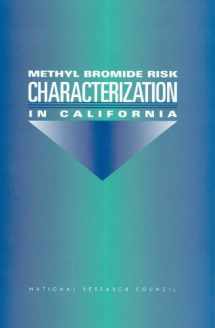
Methyl Bromide Risk Characterization in California
ISBN-13:
9780309070874
ISBN-10:
0309070872
Author:
National Research Council, Board on Environmental Studies and Toxicology, Commission on Life Sciences, Committee on Toxicology, Subcommittee for the Review of the Risk Assessment of Methyl Bromide
Publication date:
2000
Publisher:
National Academy Press
Format:
Paperback
93 pages
FREE US shipping
Book details
ISBN-13:
9780309070874
ISBN-10:
0309070872
Author:
National Research Council, Board on Environmental Studies and Toxicology, Commission on Life Sciences, Committee on Toxicology, Subcommittee for the Review of the Risk Assessment of Methyl Bromide
Publication date:
2000
Publisher:
National Academy Press
Format:
Paperback
93 pages
Summary
Methyl Bromide Risk Characterization in California (ISBN-13: 9780309070874 and ISBN-10: 0309070872), written by authors
National Research Council, Board on Environmental Studies and Toxicology, Commission on Life Sciences, Committee on Toxicology, Subcommittee for the Review of the Risk Assessment of Methyl Bromide, was published by National Academy Press in 2000.
With an overall rating of 3.7 stars, it's a notable title among other
books. You can easily purchase or rent Methyl Bromide Risk Characterization in California (Paperback) from BooksRun,
along with many other new and used
books
and textbooks.
And, if you're looking to sell your copy, our current buyback offer is $0.36.
Description
Methyl bromide is gaseous pesticide used to fumigate soil, crops, commodity warehouses, and commodity-shipping facilities. Up to 17 million pounds of methyl bromide are used annually in California to treat grapes, almonds, strawberries, and other crops. Methyl bromide is also a known stratospheric ozone depleter and, as such, is scheduled to be phased out of use in the United States by 2005 under the United Nations Montreal Protocol. In California, the use of methyl bromide is regulated by the Department of Pesticide Regulation (DPR), which is responsible for establishing the permit conditions that govern the application of methyl bromide for pest control. The actual permits for use are issued on a site-specific basis by the local county agricultural commissioners. Because of concern for potential adverse health effects, in 1999 DPR developed a draft risk characterization document for inhalation exposure to methyl bromide. The DPR document is intended to support new regulations regarding the agricultural use of this pesticide. The proposed regulations encompass changes to protect children in nearby schools, establish minimum buffer zones around application sites, require notification of nearby residents, and set new limits on hours that fumigation employees may work. The State of California requires that DPR arrange for an external peer review of the scientific basis for all regulations. To this end, the National Research Council (NRC) was asked to review independently the draft risk characterization document prepared by DPR for inhalation exposure to methyl bromide. The task given to NRC's subcommittee on methyl bromide states the following: The subcommittee will perform an independent scientific review of the California Environmental Protection Agency's risk assessment document on methyl bromide. The subcommittee will (1) determine whether all relevant data were considered, (2) determine the appropriateness of the critical studies, (3) consider the mode of action of methyl bromide and its implications in risk assessment, and (4) determine the appropriateness of the exposure assessment and mathematical models used. The subcommittee will also identify data gaps and make recommendations for further research relevant to setting exposure limits for methyl bromide. This report evaluates the toxicological and exposure data on methyl bromide that characterize risks at current exposure levels for field workers and nearby residents. The remainder of this report contains the subcommittee's analysis of DPR's risk characterization for methyl bromide. In Chapter 2, the critical toxicological studies and endpoints identified in the DPR document are evaluated. Chapter 3 summarizes DPR's exposure assessment, and the data quality and modeling techniques employed in its assessment are critiqued. Chapter 4 provides a review of DPR's risk assessment, including the adequacy of the toxicological database DPR used for hazard identification, an analysis of the margin-of-exposure data, and appropriateness of uncertainty factors used by DPR. Chapter 5 contains the subcommittee's conclusions about DPR's risk characterization, highlights data gaps, and makes recommendations for future research. Table of ContentsFront MatterExecutive Summary1 Introduction2 Toxicology and Hazard Identification3 Exposure Assessment4 Risk Characterization5 Conclusions and RecommendationsReferencesAppendix A: Biographical Information on the Subcommittee for the Review of the Risk Assessment of Methyl BromideAppendix B: Public Access MaterialsAppendix C: Calculation of Air Exchange Rates


We would LOVE it if you could help us and other readers by reviewing the book
Book review

Congratulations! We have received your book review.
{user}
{createdAt}
by {truncated_author}


